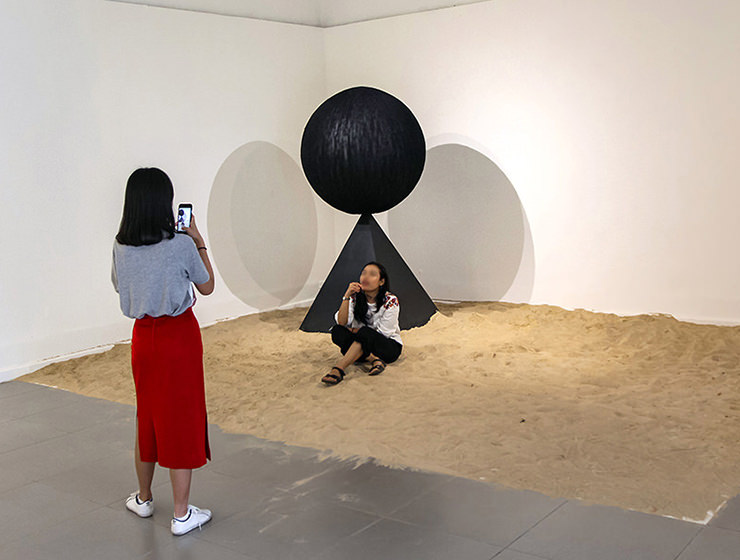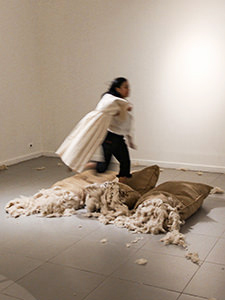Pipeaway‘s article “Selfies as declaration of stupidity: #instaidiots raping art galleries” went viral in Indonesia. Particularly among art circles, the girl who has violated some of the artworks displayed at Galeri Nasional Indonesia for the sake of making popular selfies, became a hot topic of the day/week.
As art becomes a trendy thing to talk about mainly if there is some scandal involved, the Selfie Girl, who ran over Saraswati’s artwork just for the photograph, actually made quite a good promotion for the art and its issues.
Professional circles are aware of how Indonesian visitors need education, as this is not the first time the alarm clock went on. So the incident obviously helped new discussions.
However, in social media, instead of aiming the arrows toward the gallery which obviously didn’t organize the exhibition according to the professional standards one would expect from such a famous institution, some Internet bullies directed their anger mainly toward the Selfie Girl.
Like in an unfair box match, this girl not only experienced the lesson she will remember every time she decides to visit art galleries in the future. Her bleeding head continued to be pounded while she was already gasping for air in the middle of the ring floor, in this dangerous underground fight club that social media has become.
There are other places in Asia where selfie taking has gone too far. For instance, during the Kanchanaburi sightseeing.
Selfie Girl: “I am sorry”

“I’m sorry and I regret that my behavior at the gallery was inappropriate, inconsiderate, idiotic, and ignorant”, said the Selfie Girl who contacted Pipeaway after her photos on social media reached the kind of popularity she was certainly not expecting to get.
“That morning, I woke up with a message from my friend sending me the link to your article, asking if it was me in your photos. I was shocked. But what else can I do? I answered her ‘yes’. Do I feel guilty? Very.”
I regret that my behavior at the gallery was inappropriate, inconsiderate, idiotic, and ignorantSelfie Girl
The Selfie Girl wrote me from her personal e-mail, clearly exposing her full name, but in the continuation of this article, I will refer to her as to the Selfie Girl.
I will confirm that in the meantime I blurred her face additionally. Even if Selfie Girl is 22 years old, so certainly not a teen anymore, I felt that further exposing her identity would be the similar kind of rape she practiced in the National Gallery on International Museum Day.
After her apology, her behavior should stay as an example we can discuss, but I don’t think her identity (nominal and visual) is crucial for the issues raised.
Also, the circle of violence doesn’t lead anywhere if we don’t provide ways to exit it.
Figurative language
I feel I have to bring the discussion back on track, as by reading comments on the web, it seems to me that many readers who reacted to the original article, are not used to metaphorical discourse or hyperboles.
The clearest example here is my use of the word rape when referring to what Selfie Girls did that day in the gallery.
Some sensitive person thought I was a moron as I was “equating this to rape”. I didn’t say the Selfie Girls raped the security guard or a little kid that lost his mummy. Raping the artwork does not involve sexual organs – I used the term ‘rape’ in the sense of violating something that cannot give its consent or defend. So if the dictionaries say that rape is not just an unlawful sexual activity, but also define it as “an outrageous violation” (Merriam-Webster), we might say that etymologically there was even no metaphor!
I understand readers have associations with the word ‘rape’ – but that is exactly why I used it. I wasn’t trying to impair the context of the sexual abuse. Hey, I wasn’t even talking about it!

So about what DID I talk?
First of all, what is an idiot? Sure, an idiot is a foolish or stupid person (Merriam-Webster says again). But the original English meaning was “ignorant person”.
Even more important, the idiot is an automatic digital camera without manual functions. You don’t have to be a professional photographer to be able to use the idiot camera – it’s so easy.
I never wanted to call Selfie Girls intellectually disabled! That is why I coined the term ‘instaidiot’, or more specifically – ‘#instaidiot’ (instaidiot with hashtag). It wanted to compress different linguistic tools in describing the phenomenon when the person does ignorant, clueless, or not-thought-through things for the sake of instant Internet fame (such as exposing one’s selfie on the web).
There… I wasn’t really thinking I would be explaining something that had to stay in the domain of figurative language, but when I saw that many comments, which made the original story viral, focused on the real stupidity of the Selfie Girls, I felt the discussion went the wrong way.
There were also some defending the Selfie Girls from my “bullying” attack. But the thing is – nobody went to defend the National Gallery of Indonesia, the only institution my text was about, and the only object of my “bullying” if you want to call it that.
Galleries are responsible for the artwork
The article raised the discussion, but it also enabled many to cross the line. They did the same thing Selfie Girls did but now focused on raping the rapist.
Internet comments questioning Selfie Girls’ intelligence, and origins, or just slapping them with ugly insults, overshadowed the call for the responsibility of the Galeri Nasional, the only official entity towards which the users should have actually focused their rage.
A piece of artwork made of soap was broken in half because some visitor sat on it just to take picturesTasya Nuarta
Some local artists I talked to say that this is not the first time Galeri Nasional is experiencing vandalism by the audience. Supposedly, a number of artworks have been broken during the exhibitions there. It is not an exclusive Galeri Nasional problem, but they should prove they are doing more than they actually do at the moment (exhibition with no guard in sight).
An official from a gallery in Bandung reached out to Pipeaway explaining how their gallery has sitters who are walking throughout the gallery space, but they still experience unfortunate events.
“A piece of artwork made of soap was broken in half because some visitor sat on it just to take pictures”, Tasya Nuarta shares.
I strongly advise you to read the comments below the original article, as many interesting thoughts have been shared there.
Does the artist approve of the interaction?

So why the interaction of Selfie Girls with the artwork escalated all the way to touching, manipulating, and treading the artwork?
The key lies in an unclear set of rules displayed by the gallery and the lack of human resources which would make sure the rules are followed.
Some noticed that Monica Hapsari’s work “Antara” had a written encouragement for visitors to sit in the sand and watch the rotating ball as a part of immersing in the artwork. But it certainly didn’t instruct the visitors to enjoy her artwork as the instant photo studio for selfie shots.
There is the interpretation that this permission to sit in Hapsari’s sand might have encouraged visitors to cross the line in front of the other artworks, which didn’t have this kind of instruction.
The Selfie Girl, who reached out to apologize to Pipeaway’s editor, obviously declares her confusion: “I don’t know if apologizing to you is the right thing to do, since it wasn’t you I hurt the most, it’s those artists whose works I walked and jumped over. Hey, it was allowed – there were no white lines!”
Lost in translation
It seems that the most (inter)active visitors are keen to read the instructions. So if they see white lines protecting one work, and not the other, they will come to a conclusion of their own.
Obviously, we cannot leave the responsibility of consuming the art on the piece of white tape on the floor. There will always be people who will not be able to understand the instructions (if they exist). That is why the translator (Figurative language again! Usually a gallery guard) can make sure that the rules are being followed.
The minimal protection of the gallery space would be to print “Please do not touch” signs, where it may happen that visitors could get confused by the display. If the Selfie Girls would have read it in front of Saraswati’s work “I Beg I Promise”, maybe they would have never even thought about running over it.
Some people are there just to bully. For me, it’s just the price that the selfie kid has to pay. It’s hard, but it really sets a good examplelocal artist
One of the local artists I talked to, but who wished to stay anonymous, agrees with the word ‘raping’ when we address these actions. It is escalating out of proportion, and only speaking about it can help us realize how the exhibition standards need improvement.
“Thank you so much for your article that literally saves artists’ work”, he says.
The fact is that the outcome of Pipeaway’s viral article is an increased interest of the audience for the exhibition. Supposedly visitors are queuing just to get inside!
Criticism of the public towards the gallery, as I can hear, has pushed Galeri Nasional to improve its practice. However, we are still waiting for the public statement, as clear and prompt communication with the audience is crucial for crisis management.
Democracy of exchanging opinions in Indonesia could also be improved, as my interlocutor notes: “Here, sadly, a lot of people are quite easily provoked, they tend to have this anger and rage that I don’t know where it is coming from. Pipeaway’s article did a great job of making people aware of this issue, and making that kid finally realize her mistake. But I’m just afraid not all people have educational intentions. Some are there just to bully. For me, it’s just the price that the selfie kid has to pay. It’s hard, but it really sets a good example.”
Snow White lesson: Deleting the selfies
Selfie Girl’s Instagram account is set to private mode. I wondered if any of her selfies got online in the end. Or all the hassle of running over the artwork was in vain.
“I did post some of the pictures/videos taken at the Gallery to my Instagram stories, which mostly showed just the works (well, I admit that, with no intention to disrespect, I joked a bit on the caption). From there, I got feedback from some friends merely asking what and where the event was. I only uploaded one short video of me inside the I. Christianto’s Persepsi installation (the circular mirror), I enclosed the official hashtags, title, and the author’s name in the caption… But I decided to delete it right after I read your article, purely because… I was panicking.“

Some of the other girls whose Instagram selfies were linked at the end of the original article also removed them or changed their Instagram settings to private. One was upset enough to reach out and ask why did we “steal” her picture: “Don’t you know many people judge on my Instagram?” (original quote).
It certainly does seem we are using social networks to reaffirm our position in social circles. We use them to get liked, and not judged.
It is a modern tool of beautifying our personas, both physically, culturally, intellectually… We like this mirror to show better, flawless versions of ourselves. We believe in this social media fairytale, like the queen from the Snow White story. And want to break the mirror if it actually tells us the truth.
Note: The author of the featured illustration is Adhimyr Rifky Rahman Putra (rainbow_capsule on Instagram). Check his other works here.


